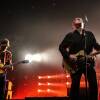Boston’s punk scene in the late 1970s and early '80s was marked by transformation.
“Boston went from being sort of a hippie, free love, granola folk rock kind of town to the emergence of Reagan, Reaganomics,” photographer Michael Grecco told GBH’s Morning Edition co-host Jeremy Siegel. “There was sort of a feeling of impending dread in a lot of society. And I think that this punk scene, it was a total rebellion.”
Grecco, who worked for the Associated Press at the Massachusetts State House during the day, would ditch his khakis and button-up shirts at night for tight jeans, ripped-up T-shirts and leather jackets. He’d grab his camera and go to see a show.
Now his photos, some of which have never been seen before, are on display at the Anderson Yezerski Gallery in the South End as part of an exhibit called Days of Punk.
His photos include members of local bands, like Human Sexual Response and Mission of Burma. They also captured The Clash, Devo and Billy Idol.
“Boston was the first city in every tour in the United States of every band that came through,” Grecco said. “Every band came through here. There was something you can do every single night of the week. And I never stayed home.”

Grecco’s archivist, Mykle Parker, suggested unearthing some of the photos for the new exhibition.
“The stuff sat in my files. I kind of ignored it. I didn't use it for my portfolio,” Grecco said. “And then my archivist started pulling stuff out. She's like, 'You've got to do something with this.'”
Grecco grew up in suburban New York “as a very sort of mothered, overly protected kid.”
He started taking trains into New York City as a teenager to see live music, especially jazz. When he moved to Boston, he wandered into The Rathskeller — Kenmore Square’s legendary punk club, open from 1974 to 1997 — “and was just, like, absolutely blown away by this scene.”
The music industry was at a pivotal moment, Grecco said.
“It's the rebellion that changed our entire music system,” he said. “You had punk on one side changing FM radio, especially the album-oriented rock stations out there. And then you had rap on the other side, blowing up things like Motown and these very slick, produced bands and music that didn't seem authentic.”
The punk scene was neither slick nor heavily produced, Grecco said. Tickets were usually around $5, and people like Grecco who were part of the music scene sometimes got in for free because they knew the bouncers.
“It was also a time where we had unfettered access and you would have things like, you know, Lux Interior of The Cramps performing at The Channel and his pants fall off and he performs the second half of the set naked,” Grecco said. “Then you go backstage to photograph Lux, and he puts his private part in a hot dog bun to do his portrait. I mean, that just wouldn't happen today.”







